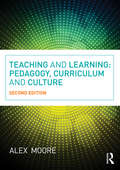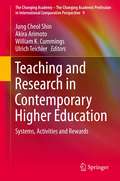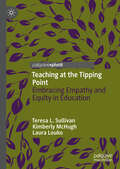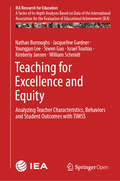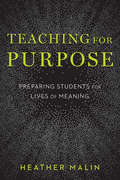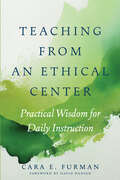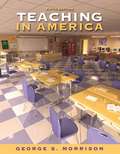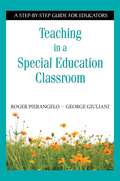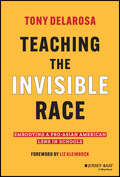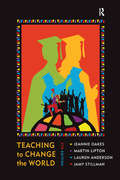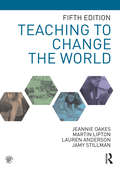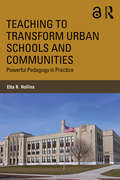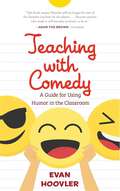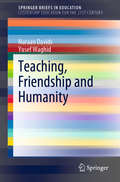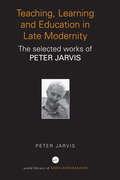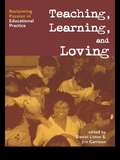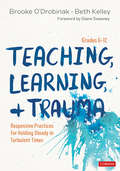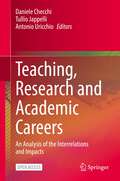- Table View
- List View
Teaching and Learning with Research Cognitive Theory: Unlocking Curiosity and Creativity for Problem-Solving Skills (SpringerBriefs in Education)
by Zubair Ahmad Noora J. Al-ThaniThis open access volume explores the transformative role of Research Cognitive Theory (RCT) in education, emphasizing its application in fostering curiosity, creativity, innovation, problem-solving skills, and cognitive development across all educational levels in students and professional development in teachers. Through detailed discussions on integrating research-based learning with STEM education, the book offers practical insights for educators, researchers, and policymakers aiming to enhance teaching methodologies and student outcomes. By bridging the gap between theory and practice, this work serves as a vital resource for those seeking to cultivate inquiry-driven learning environments. Readers benefit from actionable strategies, case studies, and a comprehensive understanding of how RCT can revolutionize modern education.
Teaching and Learning: Pedagogy, Curriculum and Culture (Itt Ser.)
by Alex MooreTeaching and Learning: Pedagogy, Curriculum and Culture is designed to share important theory with readers in an accessible but sophisticated way. It offers an overview of the key issues and dominant theories of teaching and learning as they impact upon the practice of education professionals in the classroom. This second edition has been updated to take account of significant changes in the field; young people’s use of digital technologies, the increasing involvement of world of business in state education, and ongoing high-profile debates about assessment, to name but a few. It examines the global move from traditional subject-and-knowledge based curricula towards skills and problem-solving and discusses how the emphasis on education for citizenship has forced us to reconsider the social functions of education. Central topics also covered include: an assessment of the most influential theorists of learning and teaching the ways in which public educational policy impinges on local practice the nature and role of language and culture in formal educational settings an assessment of different models of 'good teaching' alternative models of curriculum and pedagogy. With questions, points for consideration and ideas for further reading and research throughout, this book delivers discussion and analysis designed to support understanding of classroom interactions and to contribute to improved practice. It will be essential reading for all student teachers, those engaged in professional development, and Education Studies students.
Teaching and Research in Contemporary Higher Education: Systems, Activities and Rewards
by William K. Cummings Ulrich Teichler Jung Cheol Shin Akira ArimotoThis book discusses how teaching and research have been weighted differently in academia in 18 countries and one region, Hong Kong SAR, based on an international comparative study entitled the Changing Academic Profession (CAP). It addresses these issues using empirical evidence, the CAP data. Specifically, the focus is on how teaching and research are defined in each higher education system, how teaching and research are preferred and conducted by academics, and how academics are rewarded by their institution. Since the establishment of Berlin University in 1810, there has been controversy on teaching and research as the primary functions of universities and academics. The controversy increased when Johns Hopkins University was established in 1876 with only graduate programs, and more recently with the release of the Carnegie Foundation report Scholarship Reconsidered by Ernest L. Boyer in 1990. Since the publication of Scholarship Reconsidered in 1990, higher education scholars and policymakers began to pay attention to the details of teaching and research activities, a kind of 'black box' because only individual academics know how they conduct teaching and research in their own contexts.
Teaching as Communication (Effective Teacher, The)
by Bob HodgeGood teaching relies on a firm grasp of the communication process. In this innovative text Bob Hodge presents common pitfalls in the communication of teachers, and shows where they are most likely to mistake the communication of pupils. He uses practical examples which enable the reader to see an immediate and direct connection with classroom practises, making principles easier to understand and apply.
Teaching at the Tipping Point: Embracing Empathy and Equity in Education
by Teresa L. Sullivan Kimberly McHugh Laura LoukoThis book chronicles the challenges, truths, and lessons of teaching and leading in a traditional high school today: the bureaucratic red tape, the fight for inclusivity, the mental health and safety concerns, and the urgent need for teacher support and wellness. From active shooter drills to digital distractions, from closing achievement gaps to preserving educator autonomy, the challenges are immense—but so are the opportunities for change. With an honest and insightful perspective, the authors share their compelling narrative account from their extensive experiences in the trenches as both a cautionary tale and a call to action—challenging educators, policymakers, and communities to rethink how schools can truly serve students and those who teach them.
Teaching for Active Citizenship: Moral values and personal epistemology in early years classrooms (Routledge Research in Early Childhood Education)
by Eva Johansson Laura Scholes Joanne Lunn Brownlee Susan WalkerThere is strong social and political interest in active citizenship and values in education internationally. Active citizenship requires children to experience and internalize moral values for human rights, developing their own opinions and moral responsibility. While investment in young children is recognised as an important factor in the development of citizenship for a cohesive society, less is known about how early years teachers can encourage this in the classroom. This book will present new directions on how teachers can promote children's learning of moral values for citizenship in classrooms. The research provided offers important insights into teaching for active citizenship by: • providing an analysis of educational contexts for moral values for active citizenship • highlighting teachers’ beliefs about knowing and knowledge (personal epistemologies) and how these relate to children’s learning and understanding about social and moral values • discussing the impact of teachers’ beliefs on teaching practices. Evidence suggests that investment in the early years is vital for all learning, and specifically for developing an understanding of active citizenship for tolerant and cohesive societies. This book will be essential reading for the professional education of early years teachers interested in teaching for active citizenship.
Teaching for EcoJustice: Curriculum and Lessons for Secondary and College Classrooms
by Rita J. TurnerTeaching for EcoJustice is a unique resource for exploring the social roots of environmental problems in humanities-based educational settings and a curriculum guidebook for putting EcoJustice Education into practice. It provides model curriculum materials that apply the principles of EcoJustice Education, giving pre- and in-service teachers the ability to review examples of specific secondary and post-secondary classroom assignments, lessons, discussion prompts, and strategies that encourage students to think critically about how modern problems of sustainability and environmental destruction have developed, their root causes, and how they can be addressed. The author describes instructional methods she uses when teaching each lesson and shares insights from evaluations of the materials in her classroom and by other teachers. Interspersed between lessons is commentary about the rationale behind the materials and observations about their effect on students.
Teaching for Excellence and Equity: Analyzing Teacher Characteristics, Behaviors and Student Outcomes with TIMSS (IEA Research for Education #6)
by William Schmidt Youngjun Lee Nathan Burroughs Jacqueline Gardner Siwen Guo Israel Touitou Kimberly JansenThis open access book examines the interrelationship of national policy, teacher effectiveness, and student outcomes with a specific emphasis on educational equity. Using data from the IEA’s Trends in International Mathematics and Science Study (TIMSS) conducted between 1995 and 2015, it investigates grade four and grade eight data to assess trends in key teacher characteristics (experience, education, preparedness, and professional development) and teacher behaviors (instructional time and instructional content), and how these relate to student outcomes. Taking advantage of national curriculum data collected by TIMSS to assess changes in curricular strategy across countries and how these may be related to changes in teacher and student factors, the study focuses on the distributional impact of curriculum and instruction on students, paying particular attention to overall inequalities and variations in socioeconomic status at the student and country level, and how such factors have altered over time. Multiple methods, including regression and fixed effects analyses, and structural equation modelling, establish the evolution of these associations over time.
Teaching for Purpose: Preparing Students for Lives of Meaning
by Heather MalinIn Teaching for Purpose, Heather Malin explores the idea of purpose as the purpose of education and shows how educators can prepare youth to live intentional, fulfilling lives. The book highlights the important role that purpose—defined as &“a future-directed goal that is personally meaningful and aimed at contributing to something larger than the self&”—plays in optimal youth development and in motivating students to promote the cognitive and noncognitive skills that teachers want to instill. Based on a decade of research conducted at the Stanford University Center on Adolescence, the book explores how educators and schools can promote purpose through attention to school culture, curriculum, project learning, service learning, and other opportunities. Malin argues for expansive thinking on the direction schools should take, especially in terms of educating students to be creative, innovative, and self-directed critical thinkers. The book includes profiles of six organizations working in schools across the US that have made purpose development a priority. Infused with the engaging voices of purposeful youth, Teaching for Purpose offers a fresh, inspirational guide for educators who are looking for new ways to support students to succeed not only in school, but in life.
Teaching from an Ethical Center: Practical Wisdom for Daily Instruction
by Cara E. FurmanA methodology for using philosophy to guide teaching preparation and practice
Teaching in America (5th Edition)
by George S. MorrisonTeaching in America, 5/e, is a hands-on, practical text that provides pre-service teachers with comprehensive and current information about teaching in today's diverse American classrooms. The Fifth Edition promises to be the most dynamic and practical to date. With a complete redesign; a host of new research, features, and exercises; as well as a new feature box designed specifically to show pre-service teachers how use observation effectively, this text is sure to draw attention beyond its steady and loyal base. Its "working-text" style continues to provide pre-service teachers with extensive opportunities to interact with the text while establishing both the foundations of American education and a clear picture of the realities of contemporary teaching. Its increased emphasis on accountability woven throughout the text and the marginal references to INTASC standards raise the readers' awareness of key initiatives in education in the 21stcentury.
Teaching in a Special Education Classroom: A Step-by-Step Guide for Educators
by Roger Pierangelo George GiulianiDesigned for professionals working in a resource room, self-contained special class, or inclusive setting, this step-by-step guide helps new teachers in special education get their careers off to a positive start and offers experienced teachers supportive information to help improve classroom practice.Special education experts Roger Pierangelo and George Giuliani review all aspects of special education teaching, from how to get to know your students before school starts to writing end-of-the-year reports. Teaching in a Special Education Classroom offers straightforward advice to make the school year more productive for you and your students.
Teaching the Invisible Race: Embodying a Pro-Asian American Lens in Schools
by Tony DelaRosaTransform How You Teach Asian American Narratives in your Schools! In Teaching the Invisible Race, anti-bias and anti-racist educator and researcher Tony DelaRosa (he, siya) delivers an insightful and hands-on treatment of how to embody a pro-Asian American lens in your classroom while combating anti-Asian hate in your school. The author offers stories, case studies, research, and frameworks that will help you build the knowledge, mindset, and skills you need to teach Asian-American history and stories in your curriculum. You’ll learn to embrace Asian American joy and a pro-Asian American lens—as opposed to a deficit lens—that is inclusive of Brown and Southeast Asian American perspectives and disability narratives. You’ll also find: Self-interrogation exercises regarding major Asian American concepts and social movements Ways to center Asian Americans in your classroom and your school Information about how white supremacy and anti-Blackness manifest in relation to Asian America, both internally and externallyAn essential resource for educators, school administrators, and K-12 school leaders, Teaching the Invisible Race will also earn a place in the hands of parents, families, and community members with an interest in advancing social justice in the Asian American context.
Teaching the Whole Student: Engaged Learning With Heart, Mind, and Spirit
by David Schoem Beverly Daniel Tatum Edward P. St. John Christine ModeyPublished in association with Teaching the Whole Student is a compendium of engaged teaching approaches by faculty across disciplines. These inspiring authors offer models for instructors who care deeply about their students, respect and recognize students’ social identities and lived experiences, and are interested in creating community and environments of openness and trust to foster deep-learning, academic success, and meaning-making.The authors in this volume stretch the boundaries of academic learning and the classroom experience by seeking to identify the space between subject matter and a student's core values and prior knowledge. They work to find the interconnectedness of knowledge, understanding, meaning, inquiry and truth. They appreciate that students bring their full lives and experiences—their heart and spirit—into the classroom just as they bring their minds and intellectual inquiry. These approaches contribute to student learning and the core academic purposes of higher education, help students find meaning and purpose in their lives, and help strengthen our diverse democracy through students’ active participation and leadership in civic life. They also have a demonstrated impact on critical and analytical thinking, student retention and academic success, personal well-being, commitments to civic engagement, diversity, and social justice.Topics discussed:• Teacher-student relationships and community building• How teaching the whole student increases persistence and completion rates• How an open learning environment fosters critical understanding• Strategies for developing deep social and personal reflection in experiential education and service learningThe authors of this book remind us in poignant and empirical ways of the importance of teaching the whole student, as the book's title reflects.
Teaching to Change the World
by Jeannie Oakes Martin Lipton Jamy Stillman Lauren AndersonThis is an up-to-the-moment, engaging, multicultural introduction to education and teaching and the challenges and opportunities they present. Together, the four authors bring a rich blend of theory and practical application to this groundbreaking text. Jeannie Oakes is a leading education researcher and former director of the UCLA teacher education program. Martin Lipton is an education writer and consultant and has taught in public schools for 31 years. Lauren Anderson and Jamy Stillman are former public school teachers, now working as teacher educators. This unique, comprehensive foundational text considers the values and politics that pervade the U.S. education system, explains the roots of conventional thinking about schooling and teaching, asks critical questions about how issues of power and privilege have shaped and continue to shape educational opportunity, and presents powerful examples of real teachers working for equity and justice. Taking the position that a hopeful, democratic future depends on ensuring that all students learn, the text pays particular attention to inequalities associated with race, social class, language, gender, and other social categories and explores teachers role in addressing them. The text provides a research-based and practical treatment of essential topics, and it situates those topics in relation to democratic values; issues of diversity; and cognitive, sociocultural, and constructivist perspectives on learning. The text shows how knowledge of education foundations and history can help teachers understand the organization of today s schools, the content of contemporary curriculum, and the methods of modern teaching. It likewise shows how teachers can use such knowledge when thinking about and responding to headline issues like charter schools, vouchers, standards, testing, and bilingual education, to name just a few. Central to this text is a belief that schools can and must be places of extraordinary educational quality and institutions in the service of social justice. Thus, the authors address head-on tensions between principles of democratic schooling and competition for always-scarce high-quality opportunities. Woven through the text are the voices of a diverse group of teachers, who share their analyses and personal anecdotes concerning what teaching to change the world means and involves. Click Here for Book Website Pedagogical Features: Digging Deeper sections referenced at the end of each chapter and featured online include supplementary readings and resources from scholars and practitioners who are addressing issues raised in the text. Instructor s Manual offers insights about how to teach course content in ways that are consistent with cognitive and sociocultural learning theories, culturally diverse pedagogy, and authentic assessment.New to this Edition: "
Teaching to Change the World
by Jeannie Oakes Martin Lipton Jamy Stillman Lauren Anderson<P>Teaching to Change the World is an up-to-the-moment, engaging, social justice-oriented introduction to education and teaching, and the challenges and opportunities they present. <P>Both foundational and practical, the chapters are organized around conventional topics but in a way that consistently integrates a coherent story that explains why schools are as they are. <P>Taking the position that a hopeful, democratic future depends on ensuring that all students learn, the text pays particular attention to inequalities associated with race, social class, language, gender, and other social categories and explores teachers’ role in addressing them. <P>This thoroughly revised fifth edition remains a vital introduction to the profession for a new generation of teachers who seek to become purposeful, knowledgeable practitioners in our ever-changing educational landscape—for those teachers who see the potential for education to change the world. <P>Features and Updates of the New Edition: <br>• Fully updated Chapter 1, "The U.S. Schooling Dilemma," reflects our current state of education after the 2016 U.S. presidential election. <br>• First-person observations from teachers, including first-year teachers, continue to offer vivid, authentic pictures of what teaching to change the world means and involves. <br>• Additional coverage of the ongoing effects of Common Core highlights the heated public discourse around teaching and teachers, and charter schools. <br>• Attention to diversity and inclusion is treated as integral to all chapters, woven throughout rather than tacked on as separate units. <br>• "Digging Deeper" resources on the new companion website include concrete resources that current and future teachers can use in their classrooms. <br>• "Tools for Critique" provides instructors and students questions, prompts, and activities aimed at encouraging classroom discussion and particularly engaging those students least familiar with the central tenets of social justice education.
Teaching to Transform Urban Schools and Communities: Powerful Pedagogy in Practice
by Etta R. HollinsFor preservice candidates and novice teachers facing the challenges of feeling underprepared to teach in urban schools, this book offers a framework for conceptualizing, planning, and engaging in powerful teaching. Veteran teacher educator Etta Ruth Hollins builds on previous work to focus on transformative practices that emphasize the purpose and process of teaching. These practices are designed to improve academic performance, transform the social context in low-performing urban schools, and improve the quality of life in the local community. The learning experiences provided in this book guide readers through a sequence of experiences for learning about the local community that include an examination of history and demographics, community resources, local city and federal governance structures, and collaborating with other professionals. Focus Questions and a dedicated Application to Practice section in each chapter further guide learning and help make real-world connections. Designed to enable readers to bridge the gaps between theory and practice and the actual needs of urban students and their communities, this groundbreaking text helps prepare preservice candidates to make a successful transition and aids novice teachers in developing teaching practices that support academic excellence.
Teaching to Transgress: Education as the Practice of Freedom
by Bell HooksWidely admired as a leading black intellectual, hooks is also an inspired teacher. Here, she offers her ideas about teaching that fundamentally rethink democratic participation. These essays face squarely the problems of today's classrooms, including racism and sexism. Ms. hooks sees the gift of freedom--the freedom to think critically--as a teacher's most important goal.
Teaching with Comedy: A Guide For Using Humor in the Classroom
by Evan HoovlerEvan Hoovler uses his decades of comedy experience to engage students in the classroom—and now he&’s sharing all his secrets in Teaching With Comedy. Any teacher can become more effective and engaging by laughing along with these simple exercises. Instead of using &“look-at-me&” tactics to get students&’ attention, Hoovler wants to do the opposite—he uses humor to focus attention on the lesson (not the instructor) and guide a distracted class back on track. With anecdotes and explanations, Hoovler walks you through how to use certain jokes to keep students engaged and on task. You&’ll get prompts and ideas for exercises to use in your own classes, from an expert with decades of experience.Even those who aren&’t teachers will enjoy this seasoned educator&’s Dave Barry-esque takes on public schools, the history of teaching, educational philosophy, and what exactly makes a joke-telling teacher good versus unbearably corny. Teaching with Comedy is the perfect gift for any teacher or comedy fan seeking light-but-meaningful reading fare.
Teaching, Friendship and Humanity (SpringerBriefs in Education)
by Nuraan Davids Yusef WaghidThis book extends liberal understandings in and about democratic citizenship education in relation to university pedagogy, more specifically higher teaching and learning. The authors’ argument is in defence of cultivating humanity through (higher) educational encounters on the basis of virtues that connect with the idea of love. Unlike romantic and erotic love, the book examines love in relation to educational encounters whereby humans or citizens can engage autonomously, deliberatively andresponsibly, yet lovingly. The rationale for focussing on the notion of philia (love) in educational encounters, the authors argue, is that doing so allows our current understandings of such encounters to be expanded beyond mere talk of reasonable engagements—autonomous action, deliberative iterations, and simple action—toward emotive enactments that could enhance human relations in educational encounters.
Teaching, Learning and Education in Late Modernity: The Selected Works of Peter Jarvis
by Peter JarvisProfessor Peter Jarvis has spent over 30 years researching, thinking and writing about some of the key and enduring issues in education. He has contributed well over 30 books and 200 papers and chapters in books on learning theory, adult education and learning, continuing professional education, nurse education, primary school education, distance education and third age education. In this book, he brings together 19 key writings in one place. Starting with a specially written Introduction, which gives an overview of Peter’s career and contextualises his selection within the development of the field, the chapters cover: Learning Learning and Spirituality Learning and Doing Teaching The End of Modernity Learning in Later Life. This book not only shows how Peter's thinking developed during his long and distinguished career; it also gives an insight into the development of the fields to which he contributed. In the World Library of Educationalists, international scholars themselves compile career-long collections of what they judge to be their finest pieces – extracts from books, key articles, salient research findings, major theoretical and/practical contributions – so the world can read them in a single manageable volume. Readers will be able to follow the themes and strands of their work and see their contribution to the development of a field, as well as the development of the field itself. Contributors to the series include: Richard Aldrich, Stephen J. Ball, John Elliott, Elliot Eisner, Howard Gardner, John Gilbert, Ivor F. Goodson, David Labaree, John White, E.C. Wragg .
Teaching, Learning, and Loving: Reclaiming Passion in Educational Practice
by Jim Garrison Daniel ListonFirst Published in 2004. Routledge is an imprint of Taylor & Francis, an informa company.
Teaching, Learning, and Trauma, Grades 6-12: Responsive Practices for Holding Steady in Turbulent Times
by Brooke O’Drobinak Beth KelleyTransform challenging classroom experiences into opportunities for lasting student-teacher relationships, professional growth, and student engagement Chronic stress, anxiety, and trauma have startling effects on teachers and students. The pandemic and distance learning have exacerbated behavior issues and emotional dysregulation, making it difficult for students to engage, learn, and maintain healthy self-esteem. In Teaching, Learning, and Trauma, the authors guide you through the process of creating a learning environment that combats the negative effects of chronic stress and trauma. They show you how to establish rituals and routines, develop personalization, and implement effective student engagement practices that create a relationship-based culture and effectively improve student achievement. This book includes: Self-assessment tools to help teachers make informed decisions Examples of self-care plans and schoolwide policies for maintaining healthy boundaries in and out of school Real-world vignettes and samples of teacher work Planning documents and reflection questions to guide educators in identifying strengths and growth areas Using a synergistic approach, this book unites compelling research data, theories, stories, and best practices from trauma-informed schools, relationship-based psychology, and effective instructional design to dissolve obstacles caused by chronic stress and trauma.
Teaching, Learning, and Trauma, Grades 6-12: Responsive Practices for Holding Steady in Turbulent Times
by Brooke O’Drobinak Beth KelleyTransform challenging classroom experiences into opportunities for lasting student-teacher relationships, professional growth, and student engagement Chronic stress, anxiety, and trauma have startling effects on teachers and students. The pandemic and distance learning have exacerbated behavior issues and emotional dysregulation, making it difficult for students to engage, learn, and maintain healthy self-esteem. In Teaching, Learning, and Trauma, the authors guide you through the process of creating a learning environment that combats the negative effects of chronic stress and trauma. They show you how to establish rituals and routines, develop personalization, and implement effective student engagement practices that create a relationship-based culture and effectively improve student achievement. This book includes: Self-assessment tools to help teachers make informed decisions Examples of self-care plans and schoolwide policies for maintaining healthy boundaries in and out of school Real-world vignettes and samples of teacher work Planning documents and reflection questions to guide educators in identifying strengths and growth areas Using a synergistic approach, this book unites compelling research data, theories, stories, and best practices from trauma-informed schools, relationship-based psychology, and effective instructional design to dissolve obstacles caused by chronic stress and trauma.
Teaching, Research and Academic Careers: An Analysis of the Interrelations and Impacts
by Daniele Checchi Tullio Jappelli Antonio UricchioThis open access book evaluates research quality, quality of teaching and the relationship between the two through sound statistical methods, and in a comparative perspective with other European countries. In so doing, it covers an increasingly important topic for universities that affects university funding. It discusses whether university evaluation should be limited to a single factor or consider multiple dimensions of research, since academic careers, teaching and awarding degrees are intertwined. The chapters included in the book evaluate teaching and research, also taking the gender dimension into account, in order to understand where and when gender discrimination occurs in assessment. Divided into five sections, the book analyses the administrative data on the determinants of career completion of university students; increasing precariousness of academic careers, especially of young researchers; methods designed to assess research productivity when co-authorship and team production are becoming the standard practice; and interrelations between students’ achievements and teachers’ careers driven by research assessment. It brings together contributions from a large group of economists, statisticians and social scientists working under a project sponsored by ANVUR, the Italian agency for the evaluation of teaching and research of academic institutions. From an international perspective, the findings in this book are particularly interesting because despite low tuition costs, tertiary education in Italy has relatively low enrolment rates and even lower completion rates compared to those in other European and American countries.This book is of interest to researchers of the sociology of education, education policy, public administration, economics and statistics of education, and to administrators and policy makers working in the area of higher education.

